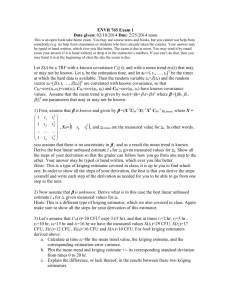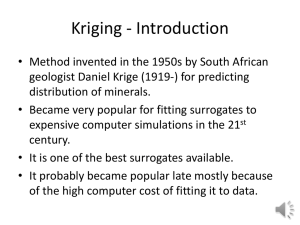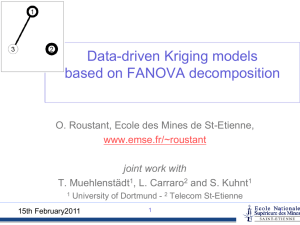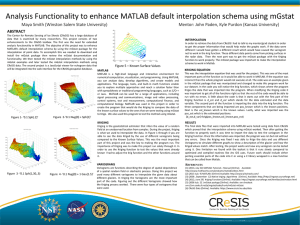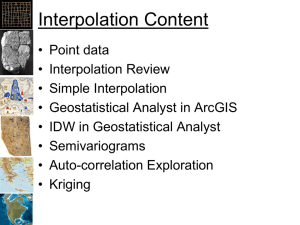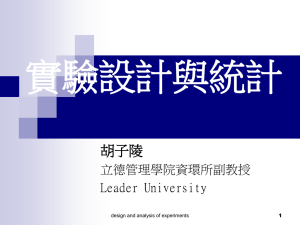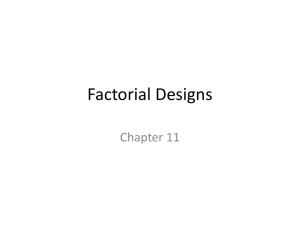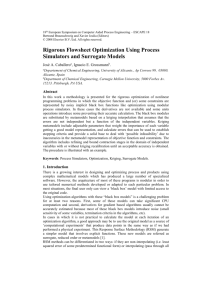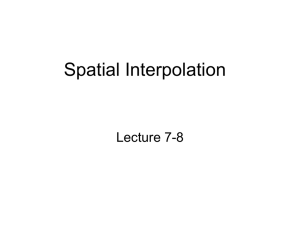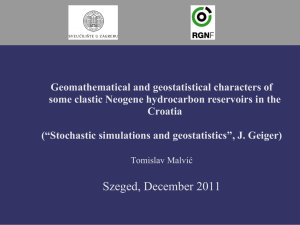Post-Fisherian Experimentation: from Physical to Virtual
advertisement
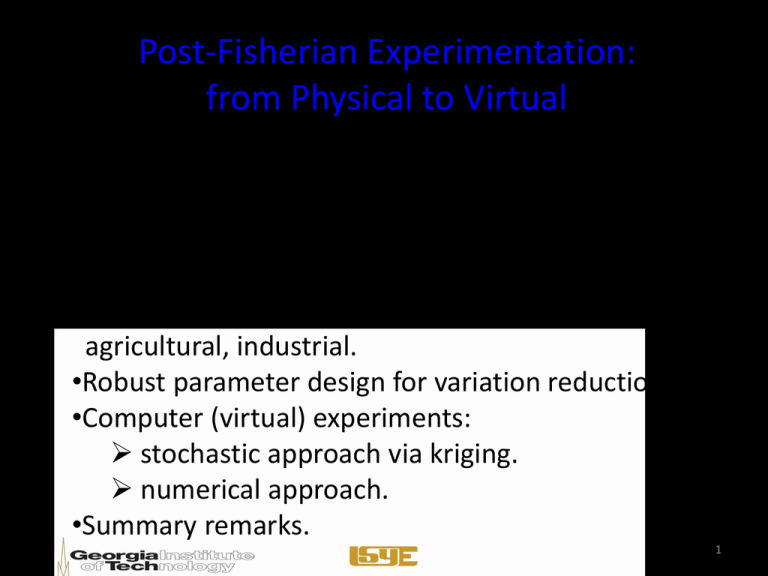
Post-Fisherian Experimentation: from Physical to Virtual C. F. Jeff Wu School of Industrial and Systems Engineering Georgia Institute of Technology •Fisher’s legacy in experimental design. •Post-Fisherian work in Factorial experiments: agricultural, industrial. •Robust parameter design for variation reduction. •Computer (virtual) experiments: stochastic approach via kriging. numerical approach. •Summary remarks. 1 R. A. Fisher and his legacy • In Oct 1919, Fisher joined Rothamsted Experimental Station. His assignment was to “examine our data and elicit further information that we had missed.” (by John Russell, Station Director ) • And the rest is history! • By 1926 (a mere 7 years ), Fisher had invented ANalysis Of VAriance and Design Of Experiments as new methods to design and analyze agricultural experiments. 2 Fisher’s Principles in Design • Replication: to assess and reduce variation. • Blocking. • Randomization. “Block what you can, and randomize what you cannot.” • Originally motivated by agricultural expts, have been widely used for any physical expts. 3 Factorial Experiments • Factorial arrangement to accommodate factorial structure of treatment/block, by Fisher (1926) . Originally called “complex experiments”. • Major work on factorial design by F. Yates (1935, 1937), and fractional factorials by D. Finney (1945); both worked with Fisher. • Major development after WWII for applications to industrial experiments, by the Wisconsin School, G. Box and co-workers (J. S. Hunter, W. G. Hunter). • What principles should govern factorial experiments? 4 Guiding Principles for Factorial Effects • Effect Hierarchy Principle: – Lower order effects more important than higher order effects; – Effects of same order equally important. • Effect Sparsity Principle: Number of relatively important effects is small. • Effect Heredity Principle: for an interaction to be significant, at least one of its parent factors should be significant. (Wu-Hamada book “Experiments”, 2000, 2009) 5 Effect Hierarchy Principle • First coined in Wu-Hamada book; was known in early work in data analysis. • “From physical considerations and practical experience, (interactions) may be expected to be small in relation to error - - “ (Yates, 1935); “higher-order interactions - are usually of less interest than the main effects and interactions between two factors only.” (Yates, 1937). • The more precise version is used in choosing optimal fractions of designs; it can be used to justify maximum resolution criterion (Box-Hunter, 1961) and minimum aberration criterion (FriesHunter, 1980). 6 Effect Heredity Principle • Coined by Hamada-Wu (1992); again it was known in early work and used for analysis: “- - factors which produce small main effects usually show no significant interactions.” p.12 of Yates (1937): “The design and analysis of factorial experiments”, Imperial Bureau of Soil Science, No. 35. • Original motivation: application to analysis of experiments with complex aliasing. 7 Design Matrix OA(12, 27) and Cast Fatigue Data 11 Full Matrix: OA(12,2 ) 8 Partial and Complex Aliasing • For the 12-run Plackett-Burman design OA(12, 211) 1 ˆ E i i jk 3 j ,k i partial aliasing: coefficient 13 ) partial aliases. complex aliasing: 45 ( 10 2 • Traditionally complex aliasing was considered to be a disadvantage (called “hazards” by C. Daniel). • Standard texts pay little attention to this type of designs. 9 Analysis Strategy • Use effect sparsity to realize that the size of true model(s) is much smaller than the nominal size. • Use effect heredity to rule out many incompatible models in model search. • Frequentist version by Hamada-Wu (1992); Bayesian version by Chipman (1996) • Effective if the number of significant interactions is small. 10 Analysis Results • Cast Fatigue Experiment: Main effect analysis: F F, D (R2=0.45) (R2=0.59) HW analysis: (R2=0.89) (R2=0.92) F, FG F, FG, D 11 A Fresh Look at Effect Aliasing • The two-factor interactions (2fi’s) AB and CD are said to be aliased (Finney, 1945) because they represent the same contrast (same column in matrix); mathematically similar to confounding between treatment and block effects (Yates, 1937). • Example: a 24-1 design with I = ABCD, generated by Col D=(Col A)(Col B)(Col C). 12 De-aliasing of Aliased Effects • The pair of effects cannot be disentangled, and are `thus not estimable. They are said to be fully aliased. • Can they be de-aliased without adding runs?? • Hint: an interaction, say AB, should be viewed `together with its parent effects A and B. • Approach: view AB as part of the 3d space of A, B, `AB; similarly for C, D, CD; because AB=CD, joint ` ` ` `space has 5 dimensions, not 6; then reparametrize `each 3d space. 13 Two-factor Interaction via Conditional Main Effects 14 De-aliasing via CME Analysis • Reparametrize the 3d space as A, B|A+, B|A-; the three effects are orthogonal but not of same length; similarly, we have C, D|C+, D|C-; in the joint 5d space, some effects are not orthogonal some conditional main effects (CME) can be estimated via variable selection, call this the CME Analysis. • Non-orthogonality is the saving grace . • Potential applications to social and medical studies which tend to have fewer factors. 15 Matrix Representation • For the 24-1design with I = ABCD A B C D B|A+ B|A- D|C+ D|C- - - - - 0 - 0 - - - + + 0 - + 0 - + - + 0 + 0 + - + + - 0 + - 0 + - - + - 0 0 + + - + - - 0 - 0 + + - - + 0 0 - + + + + + 0 + 0 16 Car marriage station simulation experiment (GM, Canada, 1988) 17 Data Factors A B C D E F + + + + + + + + + + + + + + + + + + + + + + + + + + + + + + + + + + + + + + + + + + + + + + + + y 13 5 69 16 5 7 69 69 9 11 69 89 67 13 66 56 18 CME vs Standard Analysis 19 Interpretation of C|F+ • Lane selection C has a significant effect for larger cycle time F+, a more subtle effect than the obvious effect of E (i.e., % repair affects throughput). 20 Robust Parameter Design • Statistical/engineering method for product/process improvement (G. Taguchi), introduced to the US in mid-80s. Has made considerable impact in manufacturing industries; later work in nanotechnology at Georgia Tech. • Two types of factors in a system: – control factors: once chosen, values remain fixed; – noise factors: hard-to-control during normal process or usage. • Parameter design: choose control factor settings to make response less sensitive (i.e. more robust) to noise variation; exploiting control-by-noise interactions. 21 Variation Reduction through Robust Parameter Design Design Robust Parameter Traditional Variation Reduction Control X=X1→ X=X X=X21 Noise Variation (Z) Response Variation (Y) Y=f(X,Z) 22 Shift from Fisherian Strategy • Emphasis shifts from location effect estimation to variation (dispersion) estimation and reduction. • Control and noise factors treated differently: C, N, CN equally important, which violates the effect hierarchy principle. This leads to a different/new design theory. • Another emphasis: use of performance measure , including log variance or Taguchi’s idiosyncratic signal-to-noise ratios, for system optimization. Has an impact on data analysis strategy. 23 From Physical to Virtual (Computer) Experiments Mechanical: machining, material… Chemical &Biology: nanoparticle and Polymer synthesis… Computer Experiments /Simulations Aerospace: Aircraft design, dynamics… 24 Example of Computer Simulation: Designing Cellular Heat Exchangers Heat Source Tsource z x th y h1 H h. 2 tv . . hNv w1 w2 Air Flow, Tin • • • • • w3 . . . D wNh W Important Factors Cell Topologies, Dimensions, and Wall Thicknesses Temperatures of Air Flow and Heat Source Conductivity of Solid Total Mass Flowrate of Air Response Maximum Total Heat Transfer 25 Heat Transfer Analysis ASSUMPTIONS –Forced Convection –Laminar Flow: Re < 2300 –Fully Developed Flow –Three Adiabatic (Insulated) Sides GOVERNING EQUATIONS T Qc k s A c Acq c in walls x Qh hAh T Ah qh Qf mcpT –Constant Temperature Heat Source on Top –Fluid enters with Uniform Temp –Flowrate divided among cells convection from walls to fluid fluid heating *B. Dempsey, D.L. McDowell ME, Georgia Tech 26 Heat Transfer Analysis A Detailed Simulation Approach--FLUENT • FLUENT solves fluid flow and heat transfer problems with a computational fluid dynamics (CFD) solver. • Problem domain is divided into thousands or millions of elements. • Each simulation requires hours to days of computer time on a Pentium 4 PC. FLUENT 27 Why Computer Experiments? • Physical experiments can be time-consuming, costly or infeasible (e.g., car design, traffic flow, forest fire). • Because of advances in numerical modeling and computing speed, computer modeling is commonly used in many investigations. • A challenge: Fisher’s principles not applicable to deterministic (or even stochastic) simulations. Call for new principles! • Two major approaches to modeling computer expts: – stochastic modeling, primarily the kriging approach, – numerical modeling. 28 Gaussian Process (Kriging) Modeling 29 Kriging Predictor 30 Kriging as Interpolator and Predictor 1.5 95% Confidence Confidence Interval Interval 95% 1 0.5 0 New Kriging Predictor Data Kriging Predictor True Function New Data True Function Old Kriging Predictor -0.5 -1 0 0.2 0.4 0.6 0.8 1 31 More on Kriging 32 Numerical Approach • Can provide faster and more stable computation, and fit non-stationary surface with proper choice of basis functions. • Some have inferential capability: Radial Basis interpolating Functions (closely related to kriging), smoothing splines (Bayesian interpretation). • Others do not: MARS, Neural networks, regression-based inverse distance weighting interpolator (var est, but no distribution), sparse representation from overcomplete dictionary of functions. Need to impose a stochastic structure to do Uncertainty Quantification. One approach discussed next. 33 Response Surface for Bistable Laser Diodes mc S p1 34 Scientific Objectives in Laser Diode Problem • Each PLE corresponds to a chaotic light output, which can accommodate a secure optical communication channel; finding more PLEs would allow more secure communication channels. • Objectives: Search all possible PLE (red area) and obtain predicted values for PLEs. • A numerical approach called OBSM (next slide) can do this. Question: how to attach error limits to the predicted values? 35 Overcomplete Basis Surrogate Model • Use an overcomplete dictionary of basis functions, no unknown parameters in basis functions. • Use linear combinations of basis functions to approximate unknown functions; linear coefficients are the only unknown parameters. • Use Matching Pursuit to identify nonzero coefficients; for fast and greedy computations. • Choice of basis functions to “mimic” the shape of the surface. Can handle nonstationarity. Chen, Wang, and Wu (2010) 36 Imposing a Stochastic Structure 37 Simulation Results • Left figure shows the medians and credible intervals for prediction points. • Right figure gives a detailed plot for the last 200 points. 38 Summary Remarks • Fisher’s influence continued from agricultural expts to industrial expts; motivated by the latter, new concepts (e.g., hierarchy, sparsity, heredity) and methodologies (e.g., response surface methodology, parameter design) were developed, which further his legacy. • Because Fisher’s principles are less applicable to virtual experiments, we need new guiding principles. – Kriging can have numerical problems; tweaking or new `stochastic approach? – Numerical approach needs Uncertainty Quantification, a `new opportunity between stat and applied math. – Design construction distinctly different from physical expts; `need to exploit its interplay with modeling. 39
